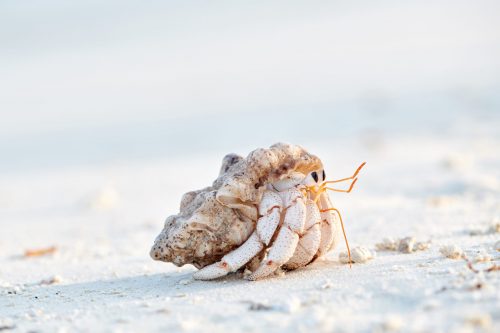Hermit crab eyes are among their most distinctive physical characteristics. The eyes, always brilliant and round, are distinctive. Hermit crabs don’t have a flawless vision, despite their size and prominence. Their unique eye anatomy allows them to see everything around them. Hermit crabs have compound eyes set on stalks that provide 360-degree vision. However, this vision is limited.
Hermit crabs can distinguish between shades and hues, but not necessarily between various shapes. For hermit crabs, smell, hearing, and touch are more reliable senses than eyesight. Although sight is not the most vital sense, excessive illumination and certain colors and hues upset hermit crabs.

The eyes of hermit crabs are similar to those of insects. Compound eyes are a feature shared by hermit crabs and other invertebrates. This indicates that the eyes are divided into ommatidia, thousands of small orbs.
These ommatidia each have separate corneal, lens, and photoreceptor cell populations. This implies that they see a far wider area than their size would suggest. Telling the distinction between lights and hues is also made easier by the abundance of lenses and cells. However, this does not imply that hermit crab vision is better than that of humans or even animals. Compound eyes are not intended to obstruct finer visual details.
Are All Crabs Colorblind?
According to a recent study, two species of crabs that reside on the seafloor can color-code to locate food. The majority of deep-sea organisms lack color vision, but the researchers claim that because these crabs are susceptible to UV light, they can tell blue light from a green light.
The crabs are searching for plankton to eat while they sit on the coral. Coral and plankton are both bioluminescent. However, the crabs must be able to distinguish between the two because the coral can be hazardous to them. But the corals also have a green glow about them,” he added. You like being able to color scheme your meals, therefore what you truly need is color vision.
The proof for the color-coding behavior was substantial, he continued, but the scientists had not yet “proved it behaviorally.” Hermit crabs might not be able to identify specific shapes just by sight. There are still conflicting views on this, and research is underway. Hermit crabs are thought to be unable to distinguish such minute details, nevertheless. For instance, they are unable to distinguish between garment patterns.
Can Hermit Crabs See The Red Light?
Only two of the many colors are visible to hermit crabs. Only blue and yellow are visible to them; grey is the only other hue. They additionally have 360-degree eyesight. In other words, they have a 360-degree field of view. The hermit crab is a nocturnal animal. In grey, they can see into the shadows.
Although they can see color, not all hues are accessible to them. Hermit crabs can only really tell the difference between blue and yellow. They have a condition known as dichromatic vision. (Dichromatic vision refers to an animal’s ability to see only two colors with its eyes since they have only two color receptors. Blue and yellow are the two hues.) Hermit crabs can distinguish between three colors: blue, yellow, and grey. Everything they can see is grey in the absence of blue and yellow. Additionally, they only perceive grey in the dark.
What Does a Crab’s Vision Look Like?
Hermit crabs have a bluish green vision, as we already know. As a result, they only perceive the world in the colors blue and yellow. Two color receptors are present. They do not require a distinct color to see because they are nocturnal creatures. Without blue and yellow, people only see pale or dark grey for all other colors.
Their eyes have a 360-degree field of vision. They can also detect motion. Their capacity for 360-degree visibility improves their capacity for hunting and protects them from other animals.
Do Hermit Crabs Prefer Light or Dark?
As hermit crabs are nocturnal animals, they like to be in the darkness. Instead, if too much light reflects off of them, they could feel anxious. They can see clearly without any UVB light. However, according to other researchers, hermit crabs may benefit from low UVB radiation. Each ommatidium supplies lights to the lenses in the dark so that they can see the world.
It is advised to keep them on a regular cycle, such as 12 hours of light and 12 hours of darkness. Alternately, you might design your aquarium so that the fish can choose to stay in the light or the dark. They are in a generally healthy habitat there.










